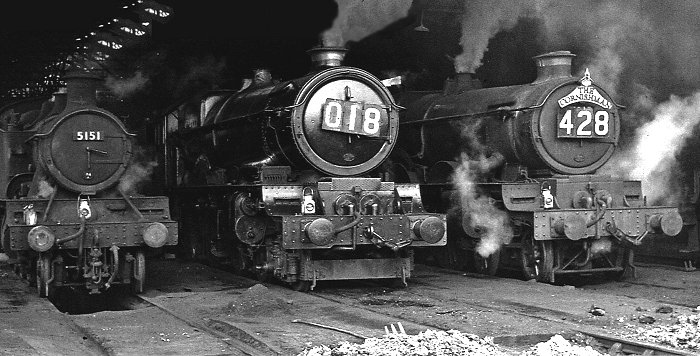
Three Collett-designed engines
await their next turn of duty from Wolverhampton's
Stafford Road shed on Friday; 17 July 1959 - '5101'
class 2-6-2T No 5151, 'King' class 4-6-0 No 6008 King
James II, and 'Castle' class 4-6-0 No 7015 Carn Brea
Castle. The 2-6-2T would see use until November 1962,
while the 'King', despite looking to be in good
condition ready to work the 8.53am Wolverhampton (Low
Level) to London (Paddington) service, had less than
three years service remaining. The 'Castle' carries a
headboard for 'The Cornishman', which was usually timed
to leave Wolverhampton (Low Level) station for Penzance
at 9.00am, with the 'Castle' working as far as Bristol;
No 7015 would serve until April 1963, by which time it
was allocated to Old Oak Common. Brian Penney. |
|
The importance of Wolverhampton as
a railway centre, and in particular the significant
presence of the Great Western Railway's Stafford Road
sheds and locomotive works, has, until recent years,
been somewhat overlooked by railway historians. Stafford
Road was designated as one of the GWR's main 'A' class
running depots and it continued as such right into
British Railways (Western Region) times, and up until
closure in 1963.
When considering any detailed
history of the locomotive shed facilities at
Wolverhampton it has to be appreciated that in the early
years (1854-69) there was an amalgam of both broad gauge
and 'narrow' gauge sheds set up on different locations.
To those unfamiliar with the peculiar topographical
layout of the works and sheds at Wolverhampton it should
be explained that the site was also laid out at
different heights and that these were bisected by the
actual main Stafford Road itself as it headed out of
town. Hence there were separate upper and lower yard
areas, often referred to as 'High Level' and 'Low Level'
which were utilised for shed and works requirements.
These should not be confused with the London & North
Western Railway and GWR railway stations close to the
town centre, which were actually named Wolverhampton
(High Level) and Wolverhampton (Low Level) respectively.
Initially, due to lack of space,
the locomotive sheds and works were all dovetailed in
together, piecemeal, and as best as possible. As a
result of opposition by a local landowner, this
difficult situation remained unresolved and it would go
on to thwart the GWR's expansion plans at Wolverhampton
right up to the early 1930s, when some additional land
(together with a Government grant) finally became
available and this allowed the modernisation and
expansion of the works to be carried out on the upper
Shrewsbury & Birmingham Railway (S&BR) side of the
Stafford Road complex, by way of cutting back a high
sandstone ridge. The various running sheds, however, all
remained on their original locations.
The GWR established itself in
Wolverhampton from 1854, and a brief description of how
this was achieved is of some assistance in understanding
the development of the Stafford Road sheds and Works
during the years that followed.
Established by the 10th century,
Wolverhampton is located 14 miles north-west of
Birmingham and it was set to become one of the largest
towns in the country, nowadays having attained
'Millennium' city status. From the late 1830s onwards
various railway companies soon began to converge on the
town, in view of its central location in the rapidly
emerging industrial heartland of England. The different
railway companies eventually settled in their final
forms in the town as the London & North Western Railway,
the GWR and the Midland Railway.
As is well-known, the Shrewsbury &
Birmingham Railway had already set up its own locomotive
works and running shed at Wolverhampton back in 1849, on
a somewhat elevated location just to the south of its
imposing blue brick viaduct at Oxley. Thus when the GWR
amalgamated with the S&BR (and the Shrewsbury & Chester
Railway) in September 1854, it also acquired, by
default, its first stretch of 'narrow' gauge main line,
together with a wonderful collection of locomotives of
various origins, shapes and sizes, all of which provided
the newly-appointed Locomotive Superintendent, Joseph
Armstrong (and subsequently his brother George) with an
ongoing task as regards stabling, maintenance and repair
for many years to come. The Act of Parliament
authorizing the amalgamation of the Shrewsbury companies
with the GWR did, however, include provisions so as to
prohibit the extension of the broad gauge beyond
Wolverhampton. Prior to 1854, the GWR entered the
jointly-owned Low Level station at Wolverhampton over
mixed gauge metals owned by the Oxford, Worcester &
Wolverhampton Railway (OW&WR), the actual GWR main line
from the south ending at a junction with the OW&WR at
Priestfield Furnaces, later to become Priest field
station.
A modest three-road locomotive shed
had already been built by the OW&WR close to Low Level
station, on spare land near the entrance to the tunnel
that brought the line in from the south. This engine
shed was taken over by the GWR and used until around
1872, when it was demolished and its compliment of
engines moved up to Stafford Road shed. |
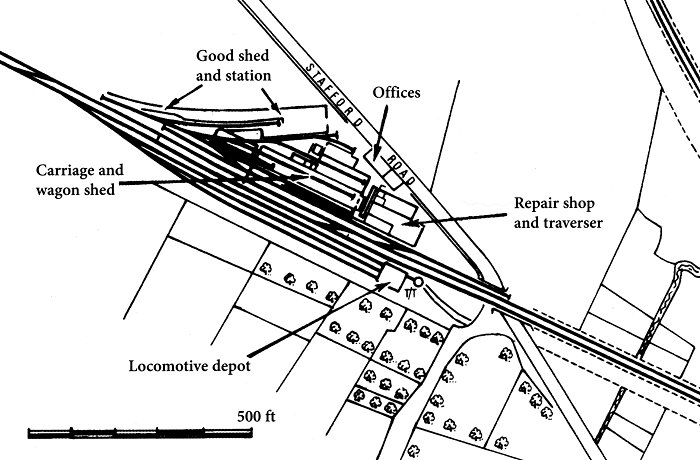
A plan of the original Shrewsbury
& Birmingham Railway locomotive shed and works, as taken
over by the GWR in 1854. Oxley viaduct is just out of
view to the left, and the Stafford Road virtually runs
south to north, so the former S&BR runs into
Wolverhampton on a near south-easterly alignment.
Author's Collection. |
|
The acrimonious legal wrangling
that arose between the S&BR and the Stour Valley Railway
(L&NWR) is well documented. Suffice to say that by the
time these differences were settled the S&BR only had a
few months of through running before being absorbed into
the GWR empire, with the L&NWR henceforth retaining
control of the former S&BR 'general' High Level station,
and then setting up its own locomotive shed at Bushbury.
Subsequent to the company mergers, both for operational
purposes and in order to deal with the broad gauge
freight traffic, the GWR laid mixed gauge track to the
north of the Low Level station and over to the far side
of the former S&BR viaduct at Oxley, a mile or so
distant, where it was intended to build another station
for the specific purpose of transferring passengers to
standard gauge coaches.
A temporary broad gauge locomotive
shed, constructed from old materials, was built by the
GWR in the latter half of 1854, on land adjacent to the
right of its main line, just to the north of Low Level
station, alongside the Birmingham Canal Navigations (BCN)
canal. As soon as the land became available, a second
(brick-built) broad gauge shed, together with an
exterior seven-road turntable, was erected on the
opposite side of the canal, and this was in use by 1857.
Old legal plans confirm that this second shed was laid
as four roads. It is not known as to how long the other
temporary shed lasted, but Daniel Gooch reported to an
expenditure committee in September 1856 that it would
'not endure another season'.
Additionally, a third broad gauge
shed (also four-road) was completed in about 1858. Sited
to the immediate left of the mixed gauge main line
leading towards Oxley viaduct, it brought the total shed
capacity up to about one hundred locomotives.
Interestingly, with regard to this shed, the official
engine house drawings from 1855 indicate that in order
to compensate for differing ground levels it was
necessary to provide a stepped sidewall running
alongside the main line, but it could only be accessed
from the Oxley side. In this case the shed was a
substantial construction (similar in appearance to
Westbourne Park) some 160ft in length and made of local
sandstone, with cast-iron supports, rectangular side
windows, and wooden-clad gable ends, of which the base
part of the stepped sidewall survived well into the
1990s.
There is some evidence to indicate
that, at best, this upper level building was only used
as a running shed for a few years, and possibly may
never have been used for locomotives at all, as by 1867
it had been merged into the works and was in use as a
smithy. This shed may well have been under construction
prior to the one in the lower yard, but in the event its
construction was put in abeyance for about 12 months
following the acquisition of the more conveniently sited
lower yard site.
As far as passengers were
concerned, the GWR's broad gauge finally terminated its
quest for the north at Wolverhampton (Low Level)
station, and as a consequence any broad gauge engines
that arrived were detached from down trains at the north
end of the station, then being taken over to one of the
sheds for servicing. Trains running between Birmingham
and Shrewsbury onwards were operated as 'narrow' gauge
in order to avoid the inconvenient change of gauge that
would otherwise have been required to take place at
Wolverhampton. Therefore, from 1854 to 1869 a mixture of
both 'narrow' gauge and broad gauge locomotives were
distributed as appropriate to the various sheds and
available yard space at Stafford Road. |
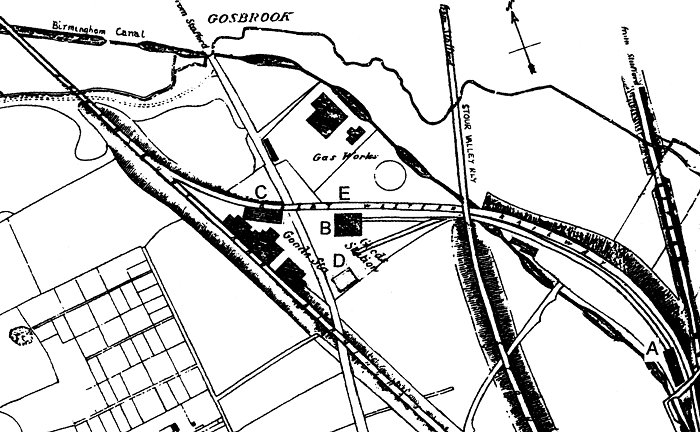
This wider plan of the Stafford
Road Works and broad gauge engine shed facilities also
dates from 1854. It is part of a town map of
Wolverhampton produced by the Borough Engineer, D. J.
Henry CE, and published in 1855. The railway systems are
presented as GWR and Shrewsbury & Birmingham Railway,
with the respective companies' buildings clearly shown.
The S&BR was amalgamated with the GWR by September 1854
but some cartographers at Wolverhampton would use the
term 'Shrewsbury & Birmingham Railway' on maps through
to the 1960s. Features of note are: (A) probable site of
the temporary broad gauge engine shed; (B) broad gauge
goods shed; (C) the sandstone-built four-track broad
gauge engine shed (tender accepted in 1856, suspended in
1857, but reinstated and completed by 1858); (D) site of
the brick-built lower yard four-track broad gauge engine
shed, authorized and completed in 1857, and extended
about 1870 by way of a timber-clad iron framework; (E)
the coal transfer stage. The need for at least three
sheds indicates that initially a significant number of
broad gauge engines were allocated, or otherwise
serviced, at Wolverhampton. Author's Collection/Courtesy
Wolverhampton Reference Library. |

One of the architectural plans
from a bound set produced in the drawing office at
Paddington in 1855. It shows the front and side
elevations of the sandstone-built four-road broad gauge
'engine house' that was erected at Stafford Road circa
1857/58. This building was about 160ft long and 60ft
wide, with eight rectangular windows in each side. A
stepped wall to accommodate differing ground levels can
be seen to the left side of the front elevation.
Author's Collection. |
|
In August 1854 the broad gauge
locomotive Dreadnought and its train survived the
collapse of a bridge at Handsworth. A subsequent
inspection by Brunel brought about the reconstruction of
several other bridges, including the one carrying the
main line over the canal at Wolverhampton. It also
provided the final approach and access into Stafford
Road shed's lower yard, beneath the arches of the L&NWR's
Stour Valley line viaduct. The second bridge was of an
arched tubular design constructed according to
directions given by Brunel himself, and this was in turn
replaced in the late 1920s by a more conventional
double-section flat-sided bridge.
Following the recommendations of
the 1845 Gauge Commission, the extent of the broad gauge
system was progressively cut back and eventually
abandoned in favour of the 'narrow' (now standard)
gauge. Among the very first lines to lose their broad
gauge rails were those in the Black Country, and 1859
saw the beginning of the slow withdrawal of stock from
Wolverhampton. Even so, it was noted on 2 November 1860
that there were no less than 14 broad gauge locomotives
present in the lower shed yard, together with these 4ft
8½in gauge locomotives - three passenger tanks, two
goods locomotives, six (Birmingham) passenger
locomotives, two (Leamington) passenger tanks, and one
(Stratford) coupled passenger tank; 28 locomotives in
all. Stafford Road was clearly becoming a busy mixed
gauge depot within the space of a few years. The old
S&BR works site was also being redeveloped and expanded
by the GWR and this work had been finalised, as best as
possible, by 1860, in order to deal with the standard
gauge locomotives, together with the addition of a
further erecting shop in the lower yard area, which
would be in use by 1875.
During the course of 1860 a new
standard gauge turntable shed was built a short distance
away from the earlier broad gauge shed, and this new
building (No 1 shed) could accommodate about 28
locomotives. Two tracks ran between the broad gauge and
the newer turntable shed, these leading to the
coppersmith's shop in the works. During the mid-1860s a
section of these tracks was covered over to provide
additional accommodation for standard gauge locomotives,
this structure becoming known locally as the 'Arcade' -
it was eventually designated as shed No 4.
Further locomotive stock was taken
on board by the GWR during 1860 and 1863, on
incorporation of the Birkenhead Railway and the West
Midlands Railway, of which some of the latter company's
engines came from the old OW&WR. Many of these engines
soon found their way to Stafford Road shed, either for
allocation or storage, pending repair or rebuilding in
the works.
The Wolverhampton Chronicle
recorded the arrival of Her Majesty Queen Victoria at
Wolverhampton (Low Level) station behind the
resplendently-decorated broad gauge 4-2-2 locomotive
Lord of the Isles, driven by Joseph Armstrong himself,
when she visited the town in 1866. This engine would
have been sent up to Stafford Road shed for servicing
and coaling prior to its return trip to Windsor.
According to a book published in 1906, the broad gauge
locomotive Great Western had also been employed for a
good many years in running express trains from London
(Paddington) to Birmingham and Wolverhampton, and thus
would have been a regular visitor to Wolverhampton
(Stafford Road) shed. |

An early 1960s view of one of
the three broad gauge engine sheds built by the GWR
at Stafford Road during the 1850s. Erected adjacent
to the mixed gauge main line to the north-west, this
red sandstone structure was started as the first of
the two permanent sheds for broad gauge engines.
Construction commenced in about 1856 but it then
appears to have been delayed in preference to
completion, in 1857, of a brick-built shed on land
in the lower yard area - a more logical site for
ease of access to and from Wolverhampton (Low Level)
station.Over the
years some confusion has arisen as to the exact
location of the sandstone shed, and the best guide
is that the side wall facing the main line is shown
in plans as having a stepped side, to compensate for
a difference in ground levels; the base section of
this stepped side wall survived into the late 1990s.
Although the official drawings show four roads of
broad gauge track, the building may never have
actually been used as a running shed as it was
incorporated into the works by 1875, for use as a
smithy. Additionally, this shed may only have been
accessed from the Oxley (north) end and, if used,
would probably have been laid out as mixed gauge.
This view is seen from the works side, looking
north, and the furthest wall was that with the
taller stepped section by the main line. The brick
building seen to the immediate right is a later
addition, after the building was incorporated into
the works complex. Simon Dewey. |
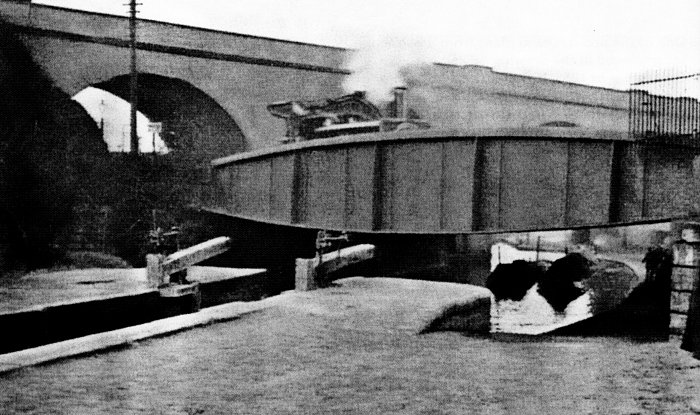
The resident works train crane
locomotive, No 17 Cyclops, built at Swindon Works in
1901, is seen during 1914 on the Brunei-design tubular
bridge over the BCN waterway. Providing access into the
shed yard at Stafford Road, this is the only known
photograph of this structure, which was subsequently
replaced during the late 1920s with a flat-sided girder
and plate bridge of a more conventional design. Crane
engines Nos 17 and 18 were in effect
Wolverhampton-designed '850' class tanks with the rear
frame extended to accommodate a steam crane; even the
wheels were of the Wolverhampton 'H'-section pattern. No
17 Cyclops was attached to Stafford Road Works from at
least 1914 until March 1934. Author's Collection. |
|
As the broad gauge requirements
continued to decrease, two of the roads in the
lower-yard broad gauge shed were converted to standard
gauge. Thus for a while, in theory, it would have been
possible to have seen both 7ft-gauge and standard gauge
locomotives side-by-side in the same shed. As from
November 1868 all passenger trains from Wolverhampton
were worked on the standard gauge, and any remaining
broad gauge goods services finished in April 1869, thus
defeating the earlier proposal for an interchange
station at Oxley. From then on, the GWR either converted
the old broad gauge sheds for standard gauge use, or
otherwise demolished or adapted these buildings for
other purposes.
The lower yard broad gauge shed was
soon converted, in 1869, for use as a tender repair shop
for the expanding works, and this was soon extended to
over double its initial length by way of adding a
cast-iron framework supporting a girder roof. The sides
of this extension and the gable end were then covered
with wooden cladding. The building was subsequently, for
a time, put to use as a paint shop.
Considering its importance both as
a main line GWR station and also a locomotive depot, it
is surprising that, so far, no photographs of any broad
gauge locomotives, either on shed or at Wolverhampton
(Low Level) station, have yet come to light. Despite
some 15 years of broad gauge working in the area, the
amount of pictorial evidence is represented by way of a
single photograph taken in about 1854 showing mixed
gauge track at an empty-looking Wolverhampton (Low
Level) station. Some other photographs also provide
glimpses of broad gauge track still in situ in Stafford
Road shed's lower yard, having survived into the late
1870s, long after removal of the actual broad gauge
system from the GWR Northern Division. Indeed the
earliest photograph taken at Stafford Road shed would
seem to be that of a Sharp, Stewart 2-2-2 locomotive, No
158, in the early 1870s. Perhaps one day some more broad
gauge railway photographs taken at Wolverhampton will
emerge. For example, it seems incredible that no
photographs were taken of the Royal Train and its
locomotive on the occasion of Queen Victoria's 1866
visit to the town, and yet even direct enquiries to the
Royal Archivist at Windsor Castle have drawn a blank in
that respect. Any attempt to provide specific details of
the various locomotives allocated to Stafford Road shed
in the early years presents a difficult task. Prior to
the 1930s, allocation details are sketchy at best, and
require consultation of the official GWR engine
registers, of which the earliest is 1902 when Churchward
instigated more accurate record keeping. Even more
obscure are the broad gauge years.
According to an article in the
Wolverhampton Railway Gazette (published in 1985) the
most interesting historical evidence indicating specific
allocations of broad gauge engines at Wolverhampton is
to be found in a book recording lists of the various
rolled plans that were deposited in Stafford Road Works
for reference purposes. A few of those plans related to
repair and maintenance details appertain to the
following broad gauge locomotives:
Salus - 12/1859 - reversing shaft
and brackets
Salus - 12/1869 (perhaps 1859?) - broad gauge worked on
Diana - 12/1859 - eccentric
Peri - 11/ 1861 - details of reversing shaft
Peri - no date - valve motion
Wolverhampton - no date - proposed stuffing box
Prince - 9/1/1858 - proposed stuffing box
Even if the date for Salus is a
mistake, it can be seen from the list that Peri (a 2-2-2
of the '1st Lot passenger') was a regular visitor in the
1860s. It is interesting to note that the broad gauge
0-6-0 goods engine Wolverhampton was also included in
the list, and in the circumstances it seems reasonable
to assume that these engines would have been allocated
to Stafford Road shed. An article in the Railway
Magazine for October 1898 referred to the derailment of
the broad gauge 0-6-0 Ariadne of the 'Caesar' class
whilst working a Wolverhampton to London goods train in
January 1861; Ariadne may also have been a regular
Stafford Road-based locomotive. |
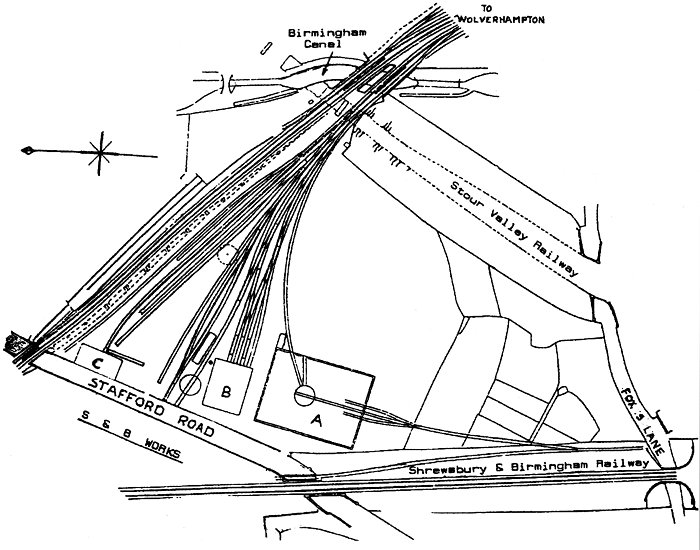
An 1867 plan of the broad gauge
locomotive yard at Stafford Road - significant features
are the standard gauge shed added in 1860 (A), the
brick-built broad gauge shed (B), and the stores (C);
the coal stage and stores were approached over
mixed-gauge track. As broad gauge requirements became
less, two of the roads in the broad gauge shed were
converted to standard gauge: the broad gauge lines in
the yard remained in situ until about 1877. Author's
Collection. |
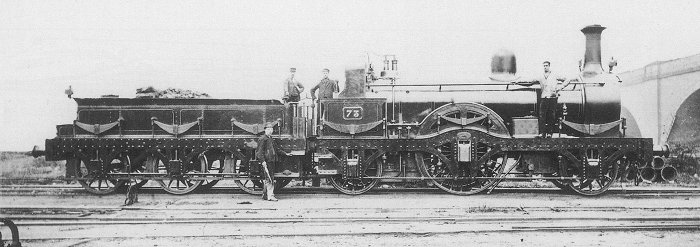
Class '69' 2-2-2 No 73 of March
1856 and its attendant crew, is positioned in the lower
shed yard at Wolverhampton. Seen shortly after its
renewal at Stafford Road Works in January 1875, No 73
ran with two spring-balance safety valves for only the
first few months after its release from the works. The
L&NWR's Stour Valley line viaduct is to the right, two
arches of which spanned the GWR main line and the access
into the shed yard and works. The GWR's 1854 acquisition
of the Shrewsbury companies, with their 'narrow' gauge
connections to Wolverhampton, made it necessary for
Daniel Gooch to provide some standard gauge engines for
main line express work. As a consequence, Nos 69-76 were
designed in the broad gauge style. Built by Beyer,
Peacock & Co during 1855/56, No 75 worked the first
standard gauge train to Oxford on 1 October 1861.
Despite its complete withdrawal from Wolverhampton in
1869, 7ft gauge track still exists in the foreground,
leading towards the old broad gauge shed, which is out
of sight to the left. The '69' class was first put to
work on trains north of Wolverhampton but subsequently,
when the standard gauge reached Paddington, they were
used on London services. No 73 was eventually
transferred to Gloucester, working from there to Swindon
and Hereford, in due course being reconstructed,
together with the rest of the class, as a 2-4-0 of the
'River' class in the mid-1890s, when it was named Isis.
It would be withdrawn from service in October 1918,
having spent its final years at Banbury. R. E. Bleasdale/Author's
Collection. |
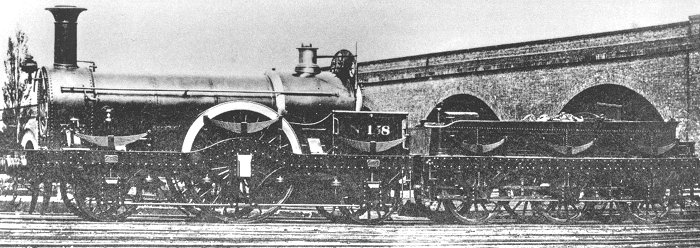
One of the earliest locomotive
photographs taken at Stafford Road, here we see
'157' class 2-2-2 No 158 in its original 1862 as
built condition. These engines, built by Sharp,
Stewart & Co, were purchased by the GWR to work the
standard gauge express trains between London
(Paddington) and Wolverhampton. As No 158 would be
withdrawn by March 1879, it is likely that this view
was taken shortly after its arrival at Stafford
Road, by the official photographer, and it would
have been housed in the 'new' No 1 standard gauge
turntable shed of 1860. Author's Collection. |
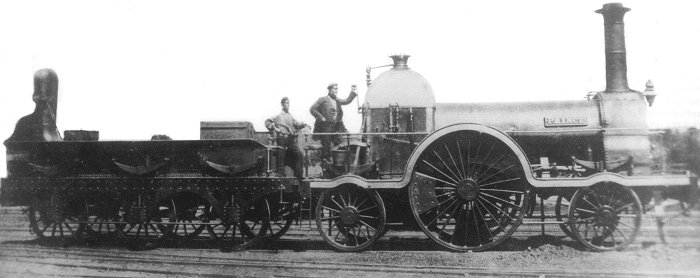
Broad gauge 2-2-2 Prince, from a class of the same name,
was built by the GWR at Swindon Works in 1846. Note the
'iron coffin' mounted above the rear of the tender - the
protective look-out post for the guard while looking
back along the train. Engines from this class are
amongst those recorded as working the Birmingham line in
later broad gauge years, this description including the
line as far north as Wolverhampton. Prince was recorded
as receiving attention at Stafford Road shed in January
1858, and it may well have been regularly allocated
there. Prince was withdrawn, without being rebuilt, in
1870, a year after broad gauge operations finished at
Wolverhampton. Author's Collection. |
 |
|
 |
|
 |
Return to the exhibition
transport services hall |
|
Return to the museum
transport hall |
|
Proceed to
part 2 |
|